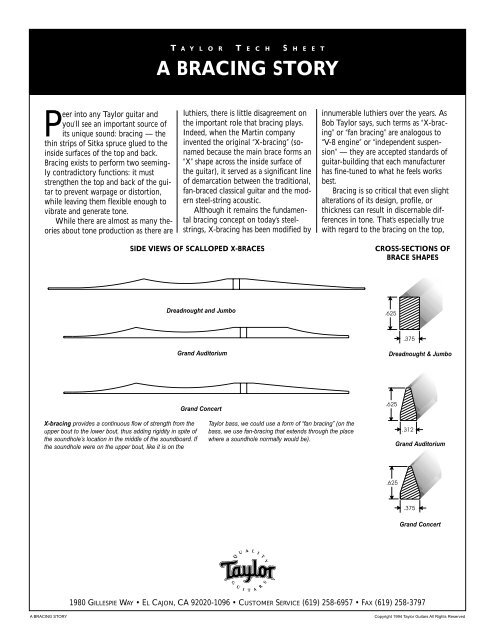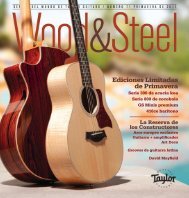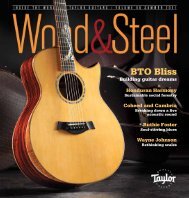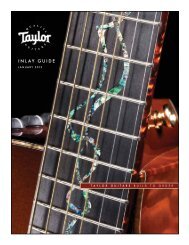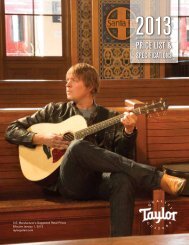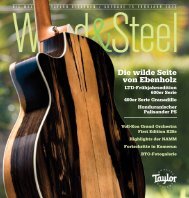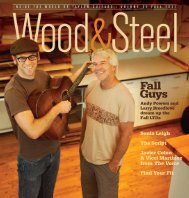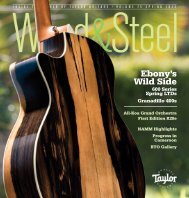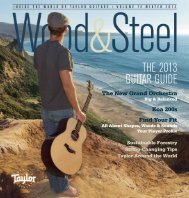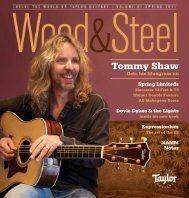Aylor a bracing story - Taylor Guitars
Aylor a bracing story - Taylor Guitars
Aylor a bracing story - Taylor Guitars
Create successful ePaper yourself
Turn your PDF publications into a flip-book with our unique Google optimized e-Paper software.
Peer into any <strong>Taylor</strong> guitar and<br />
you’ll see an important source of<br />
its unique sound: <strong>bracing</strong> — the<br />
thin strips of Sitka spruce glued to the<br />
inside surfaces of the top and back.<br />
Bracing exists to perform two seemingly<br />
contradictory functions: it must<br />
strengthen the top and back of the guitar<br />
to prevent warpage or distortion,<br />
while leaving them flexible enough to<br />
vibrate and generate tone.<br />
While there are almost as many theories<br />
about tone production as there are<br />
T A Y L O R T E C H S H E E T<br />
A BRACING STORY<br />
luthiers, there is little disagreement on<br />
the important role that <strong>bracing</strong> plays.<br />
Indeed, when the Martin company<br />
invented the original “X-<strong>bracing</strong>” (sonamed<br />
because the main brace forms an<br />
“X” shape across the inside surface of<br />
the guitar), it served as a significant line<br />
of demarcation between the traditional,<br />
fan-braced classical guitar and the modern<br />
steel-string acoustic.<br />
Although it remains the fundamental<br />
<strong>bracing</strong> concept on today’s steelstrings,<br />
X-<strong>bracing</strong> has been modified by<br />
SIDE VIEWS OF SCALLOPED X-BRACES<br />
X-<strong>bracing</strong> provides a continuous flow of strength from the<br />
upper bout to the lower bout, thus adding rigidity in spite of<br />
the soundhole’s location in the middle of the soundboard. If<br />
the soundhole were on the upper bout, like it is on the<br />
Dreadnought and Jumbo<br />
Grand Auditorium<br />
Grand Concert<br />
<strong>Taylor</strong> bass, we could use a form of “fan <strong>bracing</strong>” (on the<br />
bass, we use fan-<strong>bracing</strong> that extends through the place<br />
where a soundhole normally would be).<br />
innumerable luthiers over the years. As<br />
Bob <strong>Taylor</strong> says, such terms as “X-<strong>bracing</strong>”<br />
or “fan <strong>bracing</strong>” are analogous to<br />
“V-8 engine” or “independent suspension”<br />
— they are accepted standards of<br />
guitar-building that each manufacturer<br />
has fine-tuned to what he feels works<br />
best.<br />
Bracing is so critical that even slight<br />
alterations of its design, profile, or<br />
thickness can result in discernable differences<br />
in tone. That’s especially true<br />
with regard to the <strong>bracing</strong> on the top,<br />
CROSS-SECTIONS OF<br />
BRACE SHAPES<br />
Dreadnought & Jumbo<br />
Grand Auditorium<br />
Grand Concert<br />
1980 GILLESPIE WAY • EL CAJON, CA 92020-1096 • CUSTOMER SERVICE (619) 258-6957 • FAX (619) 258-3797<br />
A BRACING STORY Copyright 1994 <strong>Taylor</strong> <strong>Guitars</strong> All Rights Reserved
A BRACING STORY (continued from page 1)<br />
or soundboard. Bob <strong>Taylor</strong> refers to the<br />
top of an acoustic guitar as its “most<br />
valuable real estate” because it is so crucial<br />
to tone production. Legendary<br />
Spanish luthier Antonio de Torres<br />
Jurado (better-known as Torres) realized<br />
that fact 100 years ago.<br />
Just as Bob <strong>Taylor</strong> built the “Pallet<br />
Guitar” out of junk wood to demonstrate<br />
that it is the guitar maker’s design<br />
skills and not fancy materials that produce<br />
a fine guitar, Torres once sought<br />
to prove the soundboard’s sovereignty<br />
by making a guitar with a wood soundboard,<br />
but with back and sides made of<br />
papier-mâché. Reportedly, people were<br />
amazed at how good it sounded.<br />
A guitar maker purposely manipulates<br />
<strong>bracing</strong> patterns and dimensions<br />
to create his preferred tone, which<br />
becomes his aural “signature.” Although<br />
other components of a guitar’s construction<br />
(and the way it is played)<br />
influence tone production, people who<br />
describe a guitar as sounding “like a<br />
<strong>Taylor</strong>” or “like a Martin” or “like a<br />
Gibson” are making an indirect, perhaps<br />
unwitting reference to its interior<br />
<strong>bracing</strong>.<br />
In the eternal quest for better tone<br />
production, guitar makers over the<br />
years have looked for ways to maintain<br />
the support properties of <strong>bracing</strong> while<br />
increasing its flexibility. One successful<br />
method involves shaving wood from<br />
the <strong>bracing</strong> to achieve a delicate compromise<br />
between preserving its stabilizing<br />
capacity and reducing its unnecessary<br />
heft, which can make the soundboard<br />
too rigid.<br />
This scooped, or “scalloped” <strong>bracing</strong>,<br />
has become fairly standard on<br />
steel-string acoustics, with different<br />
types of scalloping used for different<br />
purposes. All <strong>Taylor</strong> six-strings, except<br />
for the Dan Crary Signature Model<br />
(DCSM), feature our own brand of<br />
scalloped <strong>bracing</strong>, which produces the<br />
warm, rich tone for which <strong>Taylor</strong>s are<br />
famous.<br />
Because our two signature models<br />
were created to suit the specific<br />
requirements of the players involved,<br />
their <strong>bracing</strong> differs accordingly. The<br />
mellow, “scalloped” tone comes somewhat<br />
at the expense of some treble<br />
overtones, so the DCSM was designed<br />
with non-scalloped <strong>bracing</strong> to deliver<br />
strong midrange and treble throughout<br />
the whole range of the guitar. Crary<br />
requires that kind of balance — treble<br />
and bass overtones both high-up on the<br />
first string and low-down on the sixth<br />
string — because the flatpicking maestro<br />
usually plays into microphones and<br />
over sound systems, which can turn a<br />
rich, warm, bass-heavy tone into distortion.<br />
Almost the reverse is the case with<br />
the Leo Kottke Signature Model 12string<br />
(LKSM). All of our 12-strings are<br />
made with non-scalloped <strong>bracing</strong>. This<br />
is because they need more <strong>bracing</strong><br />
material to: 1) handle the increased<br />
tension of twice the number of strings;<br />
and 2) prevent the top from being<br />
overdriven. The top and its components<br />
must be beefy enough to adequately<br />
amplify the tone, otherwise it<br />
will be overdriven the way a 10-watt<br />
speaker is overdriven by a 20-watt amp.<br />
Consequently, <strong>Taylor</strong> 12-strings have<br />
thicker tops, thicker pin plates, and<br />
heavy, non-scalloped <strong>bracing</strong>. [If you<br />
hear a 12-string that sounds “washed<br />
out,” it’s probably distorting due to<br />
<strong>bracing</strong> that lacks sufficient mass.]<br />
Unlike its <strong>Taylor</strong> 12-string brethren,<br />
however, the LKSM has scalloped <strong>bracing</strong><br />
that was designed to work with fat,<br />
heavy-gauge, low-tuned strings to give<br />
the guitar its characteristic, “throatypiano”<br />
tone.<br />
Recently, we changed the <strong>bracing</strong><br />
on some limited-edition Dreadnoughts<br />
to produce a tone not ordinarily associated<br />
with <strong>Taylor</strong> guitars. Generally,<br />
<strong>Taylor</strong> Dreadnought and Jumbo sixstrings<br />
have the kind of <strong>bracing</strong> mass<br />
that produces the “full-range” tonal<br />
spectrum we prefer. They shine as<br />
“plectrum” or “rhythm” guitars because<br />
they respond well to being flatpicked<br />
or strummed. But over the years, many<br />
players who love our Dreadnoughts<br />
have expressed the wish that they had<br />
that “old dreadnought bass tone.”<br />
So, we created the 810-WMB, on<br />
which we used narrower top and back<br />
braces (5/16-inch as opposed to the<br />
3/8-inch on the regular Dreadnoughts)<br />
to enable them to vibrate more and<br />
produce a boomier low end.<br />
As you can see from the illustrations,<br />
those braces inside your guitar<br />
are more than scraps of wood. Bracing<br />
is a potentially complex subject that<br />
involves the laws of physics and mass<br />
and sound. And although we can’t adequately<br />
cover the subject in one article,<br />
hopefully this will give you an appreciation<br />
of how much thought and effort<br />
go into even the most concealed components<br />
of your <strong>Taylor</strong>.<br />
1980 GILLESPIE WAY • EL CAJON, CA 92020-1096 • CUSTOMER SERVICE (619) 258-6957 • FAX (619) 258-3797<br />
A BRACING STORY Copyright 1994 <strong>Taylor</strong> <strong>Guitars</strong> All Rights Reserved
A BRACING STORY (continued from page 2)<br />
The Grand Concert is an<br />
ideal guitar for fingerstyle<br />
and recording because it’s<br />
smaller, and because its<br />
scalloped <strong>bracing</strong> was<br />
designed to produce the<br />
“<strong>Taylor</strong> tone” without the<br />
“boominess” of a<br />
Dreadnought.<br />
The Grand Auditorium’s<br />
braces are narrower; we<br />
removed mass from the<br />
width of the braces to<br />
enable the guitar top to<br />
move faster, thus creating<br />
a higher component of treble<br />
“zing” across the guitar<br />
and resulting in a snappy,<br />
bell-like tone. The GA is<br />
designed to be a strong<br />
fingerpicking guitar that<br />
also can handle medium<br />
strumming.<br />
Dreadnought and Jumbo<br />
six-strings have more<br />
<strong>bracing</strong> mass, and shine as<br />
“plectrum” or “rhythm” guitars,<br />
because they respond<br />
well to flatpicking or lightto-heavy<br />
strumming. Notice<br />
that the Dreadnought and<br />
Jumbo use exactly the<br />
same <strong>bracing</strong> pattern (i.e.<br />
the main X-brace, numberone<br />
fan brace, and fingerboard<br />
support braces, are<br />
exactly the same length on<br />
both guitars). That’s<br />
because, quite by accident,<br />
the two guitar shapes,<br />
although obviously different,<br />
intersect each other at<br />
the brace ends. And that is<br />
one reason why it’s hard to<br />
describe the difference<br />
between the tone of a<br />
Jumbo and a Dreadnought.<br />
They are, in fact, very similar<br />
guitars.<br />
Our Dreadnought and<br />
Jumbo 12-strings have<br />
thicker tops, thicker pin<br />
plates, and heavier <strong>bracing</strong>,<br />
both to handle the<br />
increased string tension<br />
and to prevent the top from<br />
being overdriven. They are<br />
designed to deliver a beautiful<br />
response at concert<br />
pitch (as opposed to the<br />
lower-tuned LKSM).<br />
1980 GILLESPIE WAY • EL CAJON, CA 92020-1096 • CUSTOMER SERVICE (619) 258-6957 • FAX (619) 258-3797<br />
A BRACING STORY Copyright 1994 <strong>Taylor</strong> <strong>Guitars</strong> All Rights Reserved


